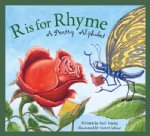Over the years, I have often heard people say, "Oh, I don't like poetry, I much prefer prose." I am willing to bet that these people have not have the good fortune to read Lewis Carroll's The Walrus and the Carpenter or Langston Hughes' My people. Since I started reviewing books for young readers, I have encountered poems that make me howl with laughter, or that are so moving that I get a lump in my throat. I have encountered whole novels written in blank verse, and poetry forms that I had never even heard of, like acrostic poems.
In today's poetry title you will meet and experience a wide variety of poetry forms. You will see how they are written, and discover the many effects that they can have.
Judy
Young
Illustrated by Victor Juhasz
Nonfiction Picture Book
For ages 6 to 10
Sleeping Bear Press, 2006, 978-1585362400
For many of us, rhymes and lines from poems form some of our earliest book memories. Mother Goose, Robert Lewis Stevenson's famous poems, "The Owl and the Pussycat," and many others all give us phrases that we remember well into adulthood. In this unique alphabet book, readers will get to meet a whole new set of poems, each one of which show us that poems come in many different faces and forms. Among others we meet a sonnet, a ballad, a haiku, a jingle, and a limerick. Then there are the parts of poems that give them their unique qualities; their rhymes, rhythms, their metaphors, narratives, quatrains, and free verse elements.
Illustrated by Victor Juhasz
Nonfiction Picture Book
For ages 6 to 10
Sleeping Bear Press, 2006, 978-1585362400
For many of us, rhymes and lines from poems form some of our earliest book memories. Mother Goose, Robert Lewis Stevenson's famous poems, "The Owl and the Pussycat," and many others all give us phrases that we remember well into adulthood. In this unique alphabet book, readers will get to meet a whole new set of poems, each one of which show us that poems come in many different faces and forms. Among others we meet a sonnet, a ballad, a haiku, a jingle, and a limerick. Then there are the parts of poems that give them their unique qualities; their rhymes, rhythms, their metaphors, narratives, quatrains, and free verse elements.
For every word in this alphabet book, the
reader is given a poem to read, to enjoy and to explore. Each poem helps to
illustrate the word that is being described. Thus, the reader can actually see
what iambic means, laugh at a limerick, and hear onomatopoeic words. The author
includes an in depth description of each word, explaining when certain forms
are used, what effect they have, and what the history of the form is.
This book certainly is one of the most
creative poetry picture books that has been published because it not only gives
us poems to read, but it also helps us to better understand the whole wonderful
world of poetry, and to see that poetry can convey a feeling or an impression
in an unforgettable way.

No comments:
Post a Comment